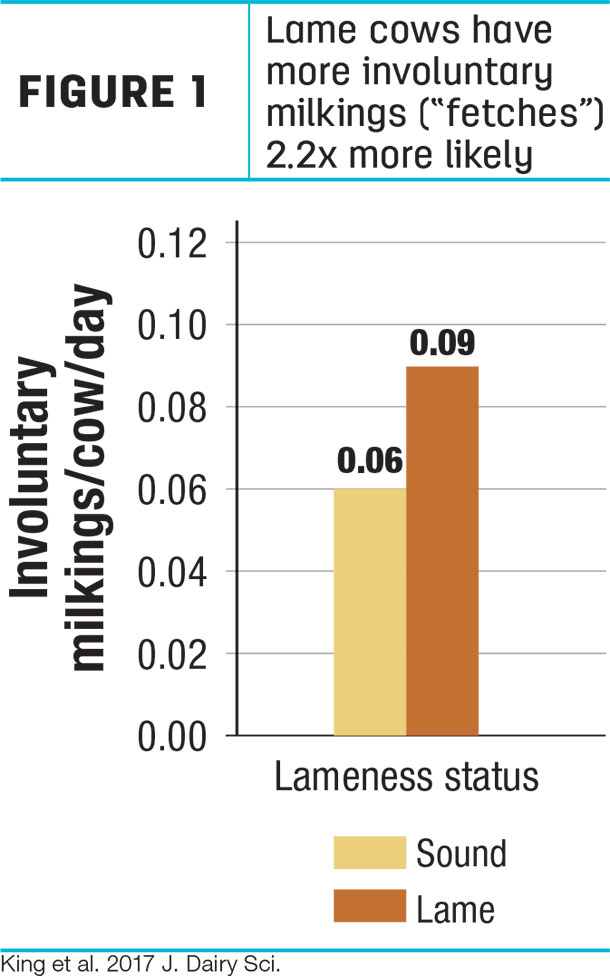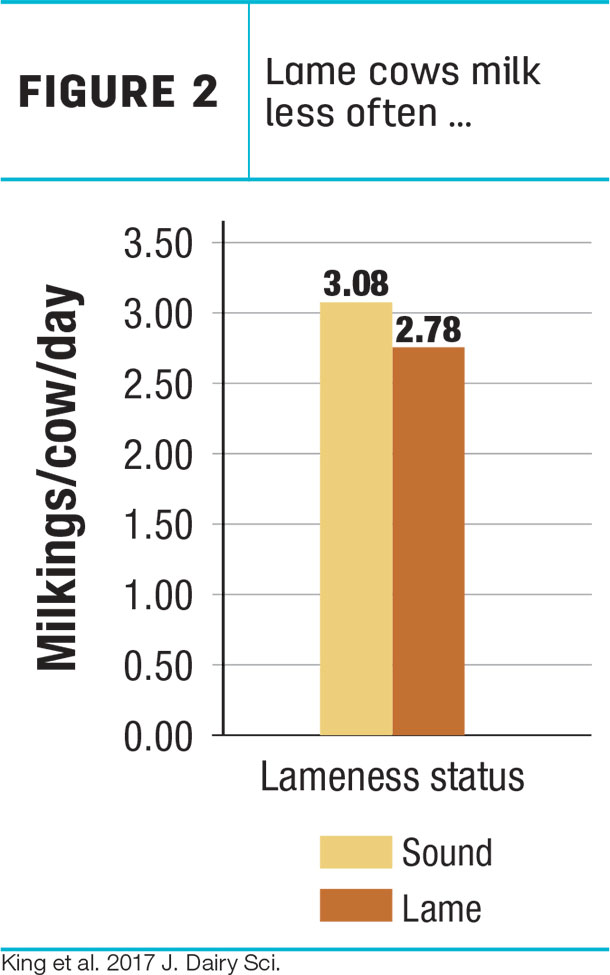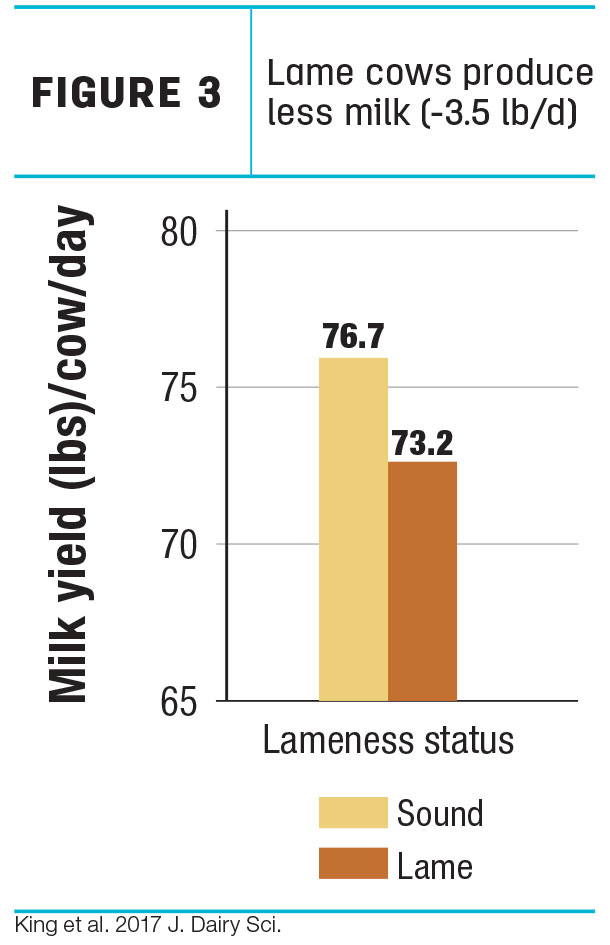Just as in traditional facilities, cows spend their day in a robotic barn eating, milking and resting. But when these daily behaviors are interrupted or restricted, neither the cows nor the robots perform at their peak.
During the 2018 Cornell Cow Comfort Conference, Trevor DeVries from the University of Guelph shared results from several Canadian robotic dairy studies, revealing an environment that promotes cow comfort and ease of movement to and from the milking robot are critical factors in the system’s success.
“To ensure cows have the time and desire to milk voluntarily, they need good mobility, comfortable stalls and good access to the milking unit, lying stalls and feedbunk,” DeVries said.
1. Good mobility
Simply stated, cows need to be able to get up and walk easily and on their own to be milked. According to DeVries, lame cows are 2.2 times more likely to be fetched, making them especially problematic in automated milking environments (Figure 1).

Research shows cows walking with a limp make fewer visits to the robot, with 2.78 visits per day for lame cows compared to 3.08 visits per day for sound herdmates (Figure 2).

The impairment shows itself through lost milk production, as lame cows produce 3.5 pounds less than non-lame cows daily (Figure 3).

Regular hoof trimming and footbathing are the “biggest things farms are doing to improve lameness,” but when it comes down to it, DeVries said cows are lame in robot barns for the same reasons they are in other facilities.
“The risk factors found in the study are not different from what we see in conventional herds,” DeVries said. “Mostly, it’s related to the environment of the cow and her ability to lie down in the stall.”
2. Comfortable stalls and resting surfaces
Stall size and design can either encourage or discourage cows from lying down and resting. DeVries said lameness prevalence is greater when cows don’t fit in their stalls, therefore spending less time lying in a stall and more time standing.
Another stall design risk factor is obstructed lunge space, which is related to a 1.7-times-higher risk of lameness. DeVries has observed facilities where stalls are not lined up with the barn’s support posts, thus limiting the space available for the cow to lunge forward. He has most often seen this obstruction in three- or six-row barns.
DeVries noted further correlations between facilities and lameness:
- Cows were 1.9 times more likely to be lame when feed alleys are less than 14 feet wide.
- Lameness was 1.6 times higher for cows kept on mattresses compared to sand bedding.
Adequate amounts of top bedding to mattresses can “provide the same level of comfort, reduce the risk of abrasions and provide for sufficient lying times,” DeVries said.
3. Good access to milking units, lying stalls and feedbunk
Barn layout and management impacts the cow’s ability to be milked. DeVries acknowledged both guided-flow and free-flow barns can be successfully managed, but each also has risk factors. In a guided-traffic barn, cows may experience longer waiting times and eat fewer meals; in a free-flow barn, more fetching is often required.
Stocking density also affects cows’ desire to get up, move and be milked. “When they are overstocked, cows are less motivated to get up,” DeVries noted.
On average, herds milking about 50 cows in a robotic unit saw milking frequency drop by 0.22 times per day for each increase of 10 cows per unit. Another study showed fetching rates increased with more than 60 cows in a pen, the equivalent of one extra cow per day for each 10-cow increase.
Stocking density matters at the feedbunk too. Research conducted in 2011 on robotic dairies in Ontario showed for every 4-inch increase in feedbunk space, cows made 3.75 more pounds of milk and spent an additional 0.39 hour per day lying in their stalls.
“Lying time increases are quite telling. If we are providing cows the space they need to eat … we are allowing that cow to use her time efficiently … and she’s devoting more time to lying down,” DeVries said.
Other studies did not reveal a difference, yet DeVries said no evidence suggests we can get away with less feedbunk space in robot barns. However, good management can make less space work in these situations: milk-first guided flow barns, when only forage is provided at the bunk and when feed is delivered multiple times per day.
“Milking activity is inherently tied to feeding activity,” DeVries said. There is often a spike in milking activity tied to feeding management throughout the day; the more frequently feed is delivered or pushed up, the more cows are stimulated to go to the bunk. “It also motivates cows throughout the day to get milked at different times, thus improving efficiency of the robot,” he added.
Frequent feed push-ups are further associated with increased lying time. A 2016 study of robotic herds that pushed up feed on average eight times per day observed an additional 0.1 hour of lying time per every extra two push-ups per day. Consequently, when feed is not readily available at the bunk, cows spend more time standing. DeVries added, “If feed is not in front of them, it’s a waste of cows’ time.”
“We can do a lot of things related to stalls and flooring that affects lying time, but never before have we looked at feed management and lying time,” DeVries said. “This is the first evidence to show making feed available allows cows to spend more time lying down.”
The keys to cow comfort in a robotic barn come down to minimizing lameness with appropriately designed and sized stalls; facilities that promote eating, resting and milking; and other factors like feed availability. ![]()
PHOTO: “To ensure cows have the time and desire to milk voluntarily, they need good mobility, comfortable stalls and good access to the milking unit, lying stalls and feedbunk.” Photo by Mike Dixon.
References omitted but are available upon request. Click here to email an editor.

-
Peggy Coffeen
- Editor
- Progressive Dairyman
- Email Peggy Coffeen





